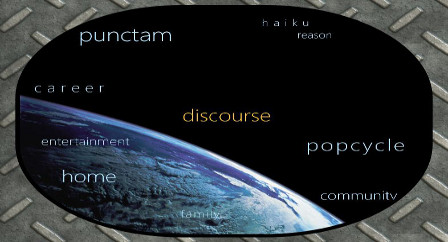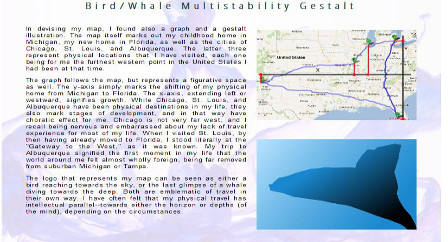Our [Electrate] Stories
Explicating Ulmer's Mystory Genre
Marc C. Santos, Ella R. Bieze, Lauren E. Cagle, Jason C., Zachary P. Dixon, Kristen N. Gay, Sarah Beth Hopton, Megan M. McIntyre
Reflection: Jason C.i
1. What work does a mystory do?
Mystory is a new way to see the canon of invention in digital spaces. Unlike print-era conceptions of literacy, the mystory reimagines what counts as generative of meaning and discourse in the jump to electracy. I take from the mystory that a traditional conception of logos isn't robust enough to characterize the dynamic rhetorical activity of electracy, where the personal meets the civic and rhetorical in generating meaning online. This is because electracy, unlike the age of literacy that precedes it, includes emotion in its model of reasoning. That is to say, in electracy, images, sounds, moods, and feelings are an integral part of reasoning (see, for instance, my Wide Emblem page that attempts to capture the mood of the mystory process in an interactive emblem). What might have once been considered an artifact or an accident of experiencing a text in literacy becomes instrumental and paramount to rhetoric in electracy.
In order to examine this, I find that the mystory exercises call into question a lot of the sterilizing we do in teaching and learning. For Gregory L. Ulmer, electracy expedites the importance of reflecting on and being aware of the self. Often this includes recovering a personal relationship to learning and knowning that, in my case at least, is viewed as superfluous.
Ulmer channels the French philosopher and literary scholar Roland Barthes in order to conceive of these superfluous or accidental elements. For Barthes, viewing a photograph involves two sets of experiences: the studium and punctum. According to Ulmer (2003), "The meanings that are namable in a photograph are called 'studium' (constituted by the public encyclopedia of concepts) and the obtuse meanings 'punctum'—that which stings or pricks one emotionally" (p. 44). For Ulmer, the mystory is a recording of the punctum, the obtuse meanings, of one's relationship to the four discourses. These emotional stings are the personal notions of learning and inventing that are accidental in literacy, but fundamental in electracy.
It is not hard to imagine how graphics and sounds are important to the multimodal landscape of writing online, but recognizing their implications for meaning and reasoning is another story (a mystory). Ulmer does not ask for a superficial adoption of new media composing practices within a structure of literacy, but rather a wholesale investment in a radically new and deeply personal kind of meaning making: electracy.
2. Does the mystory realize Ulmer's aspirations? How does that line up with what we said we think Ulmer is trying to accomplish?
As a step towards understanding the relationship between the punctum, modes of reasoning, and invention for electracy, the mystory certainly realizes Ulmer's aspirations. The discourses ask the rhetor to reflect on the implications of electracy in their own life and to explore and invent new modes (for instance, this gestalt map as a new mode) in the process. The vague and at times bizarre exercise directions felt appropriate where traditional reflections would have been tired and uneventful.
While the mystory is a reflection on the forgotten and dismissed components of the self in electracy, it is perhaps not a demonstration of their importance. Where I am perplexed by Ulmer's aspirations is in the output of knowing thyself. I have seen the discourses through the lens of electracy, but I'm unsure of how I might harness that perspective towards any other means than the creation of another mystory.
3. Can/should you learn Ulmer while learning HTML and CSS?
Certainly you can. The two inform each other in my experience, as they both ask us to reconceptualize the canon of invention in a digital space. Of course, Ulmer himself notes that it isn't necessary, but I think learning the two in tandem offers a more appropriate and complex mode to explore Internet Invention (2003). HTML and CSS can look rigidly rule-bound at first but truly offer avenues that extend well beyond the confines of a printed page with a little mastery.
4. Should a mystory be public or private?
I see the mystory as an appendage of my larger, more amorphous, web persona that does not necessarily reflect my non-web identity. So, I didn't feel as much like I was revealing as much as inventing. For me, the mystory was personal, but not so intimate that I was uncomfortable with it as a public text.
That said, I do think that keeping it private is easily reconcilable with the goal of the mystory, since it is a private experience meant to inform about the self. At the same time, a public mystory engages with the logic of a Web 3.0—a public, open web that is also personalized and nonlinear. In all, I have trouble deciding on just one or the other, and I think that the public/private decision ought to be made individually. While there are perhaps few benefits to publicizing the mystory (and several drawbacks), it nonetheless seems in the spirit of the kind of work Internet Invention (Ulmer, 2003) is preparing students to confront.
5. What else do you want to say?
I am left wondering at the role the mystory plays in changing the self—that is, in changing the reader/rhetor of Internet Invention (Ulmer, 2003) to better know him/herself in an electrate world. The mystory asks for a great deal of personal reflection, and often at the cost of reopening old wounds. Psychological ramifications abound in Internet Invention, and perhaps Ulmer is a bit cavalier in asking the EmerAgency to turn the tools of deconstruction on themselves.
There is, though, another way to see the mystory I think. I don't see Internet Invention as a way to deconstruct the self, as many will, but rather as a new way to construct it. For Ulmer, something has been lost about the self in the epoch of literacy, something that should be recovered in electracy. His utilization of Roland Barthes’ punctum elements of a photograph is one such relay for understanding what this loss means to electrate reasoning. Rather than tearing down—deconstructing—yet again, I found the mystory to be a collecting back of my personal relationship to learning. The mystory functioned for me as a way to gather elements of my relationship to the past—to see how digital meaning might be associated with emotions and the stings of Barthes’ punctum.
For Ulmer (2003), “electracy includes emotion in its model of reason” (p. 76). In this way, gathering back the punctum is a constructive enterprise, not a deconstructive one, as it gathers back the shed, punctum, elements of reason and the self. Though the mystories ask for a great deal of self-inspection, it does so with the intention of gathering up a few of the forgotten parts of one’s personal relationship to learning and inventing. For this alone it is refreshing for students like myself who are taught to value clarity (studium) and sterilize or forget the accidental (punctum).
6. Did you have an aha moment?
As previously described in the Introduction, each of the four mystory discourses is intended to offer insights into the ways in which different discursive networks influence what we do, and do not, see. When viewed this way, it is perhaps a knee-jerk vestige of the epoch of literacy to reflect exclusively on the content of career, family, entertainment, and community. Yet, as Ulmer notes, simply porting literacy practices to online environments does not fully recognize a shift to his notion of electracy. In this vein, my most notable aha moments came in playing with (and stumbling through) the affordances of new media while designing the mystory pages.
This is not to say, though, that the design and content of the mystory ought to be viewed as separate processes. Though in hindsight my mystory is a novice attempt at understanding professional web design practices, it was heavily influenced by my interpretation of Ulmer and the content I was creating. This was the aha moment of my mystory experience, realizing that sounds, images, motion, and content were all bound up in the meaning making practices of the discourses and electracy. Stripping the CSS style elements that provide the overal design from my mystory takes away more than just a subordinate layer of meaning from the whole. The design, at least as it was intended, is just as much content as the traditional, linear text elements.
In thinking of design this way, it is easier for me to see the sometimes fluid and sometimes colliding relationships between each of my separate discourses. I'd like to think that—again, even if they are novice attempts—the homepage design and the navigation design for individual discourse pages (for example) are telling a story of my relationship to career, family, entertainment, and community just as much as the linear texts. Or, rather, new media allows for an experience with the mystory that is fundamentally different than an experience with what might be thought of as just the content of the discourses. The most salient point here, I think, is not that someone viewing my mystory today will notice these elements and have a different reading, but rather that I had a different reading of my own experiences while composing the discourses because of new media.


